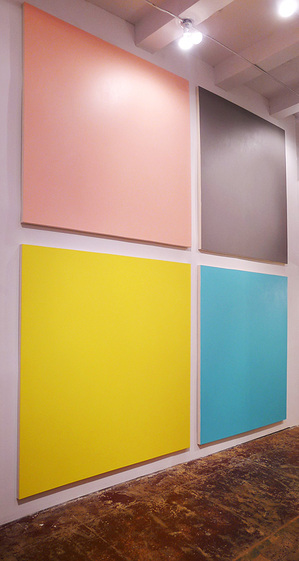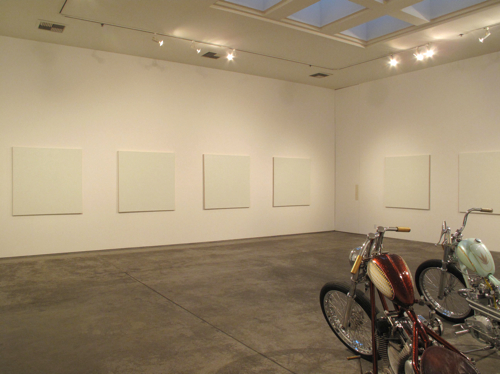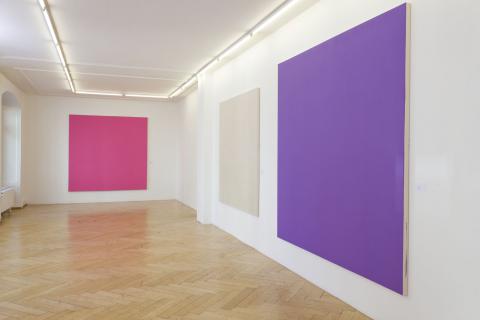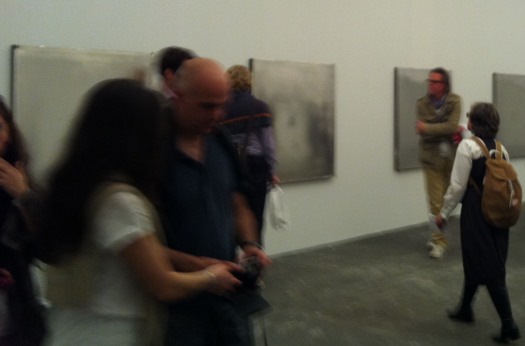
Henry Codax, Untitled (Dark Grey), 2011, via christies.com
Wow, do I owe Henry Codax an apology.
Last week I'd declared the fictitious painter's beautiful gray monochrome a failure because, not only did it not "Strip away any obvious authorship," the Christie's catalogue text for the painting laid authorship down in thick coats by stating as fact that Codax was "a pseudonym created by New York-based artist Jacob Kassay and the Swiss conceptual artist Olivier Mosset."

installation shot, Henry Codax paintings, Carriage Trade, June 2011
I'd been surprised to see the attribution laid out so definitively, especially after re-reading the source of that attribution, Andrew Russeth's Gallerist NY article on the Codax show last summer at Carriage Trade. Russeth did indeed report that "a source"--who he did not characterize in any way--had told him about the Mosset/Kassay collaboration, but Carriage Trade would not comment on Codax's origins--and still won't, btw--and both real-life painters' galleries stated they had no idea about the work or the project.

Olivier Mosset paintings installed with bikes by Jeffrey Schad and Vincent Szarek, 2011, Christopher Grimes Gallery, Santa Monica
In the Wikipedia age, though, where truth is trumped by verifiability, Russeth's article was proof enough for the paintings to find buyers. And for at least one buyer, who apparently figured they'd cash in on the recent Kassay mania by flipping the dark grey monochrome at auction. And for Christie's, who ignored the work's similarities to the venerated-but-less-marketable Mosset's work to assert that "In the present example, Kassay's iconic silvery paintings have been replaced by a sleek, anonymous grey surface."
Yes, well. Actually, no.
At Christie's First Open sale last Wednesday morning, the Codax had been bought in, which means it didn't sell, either because bidding didn't reach the reserve price, or because there was no bidding at all. At first, I'd figured the work wasn't Kassayish enough after all, or that its conceptual conceits were too cute for the speculators in the market.

Henry Codax and Stephane Kropf at Susanna Kulli Gallery, Zurich, Oct. 2011
But then someone who attended the sale told me that Christie's had read a statement, known as a saleroom note, before bidding began, in which Kassay said he'd "had nothing to do with" the painting, and that his "name should not be associated with it." [In trying to confirm the text of the actual statement, I contacted Christie's, first as press, and then finally as client. The specialist who worked on the lot was helpful, if circumspect. But she also referred me to the sale results page, which, I was told, would have the saleroom notice appended. Except, of course, it didn't, because Christie's deletes online references to unsold lots completely, in order to not taint their saleability in the future.]
Whatever was said was apparently enough to dissipate the Kassay cachet. [Christie's did not receive a similar demand from Mosset.] But more importantly, or more interestingly, it also reopened the speculative possibilities surrounding Codax's work and who might have made it. And how it closes and generates gaps between an object and the projections upon it.

Olivier Mosset work in 1107 Manhattan Ave, a group show at Spencer Brownstone, which also included works by studio neighbor Kassay, Sept. 2011
The real [fictional] Codax, the character in Bernadette Corporation's collectively authored novel Reena Spaulings, was known for "expensive, impressive monochromes." Yet these were neither, and after failing to sell at auction, they were even less so. Reviewing the show for Frieze, Piper Marshall noted the authorship issue's resonance with Mosset's earliest practice, when, as BMPT, he and three fellow painters, Daniel Buren, Michel Parmentier, and Niele Toroni, would make and sign each others' work.

Jacob Kassay installation, eight square, silvered paintings at Art Basel, June 2011, image via gallerist ny
But once Gallerist published their persuasively well-informed speculation, these large, uniform, anonymous paintings suddenly became a roomful of *wink* Kassays, which, unlike the roomful of square Kassays just shown at Basel, were available to buy. Even if you weren't "a real museum." And at up to 95% off. As long as you didn't mind the uncertainty. And as long as you were happy with an unsigned painting accompanied by a certificate authenticating the work only as by "Henry Codax." And if the work is ever captured by the market, the artists will deny all knowledge of its existence.
Our capitalist culture is based upon the premise that corporations are people, too, and legal disputes are regularly resolved by exchanges that include "no admission of wrongdoing." With a political system where plausible deniability is S.O.P. and legal motions are made that "neither confirm nor deny" their subjects. It does makes one wonder why the art market can't accommodate a painting by a fictitious artist derived from a collectively written novel by a fictitious gallerist published by a corporation, even without the unconfirmed involvements of two well-known, living artists.
So Henry Codax, I sincerely apologize, and I salute you, for you are truly an artist of our time. C-A-L-L M-E.












